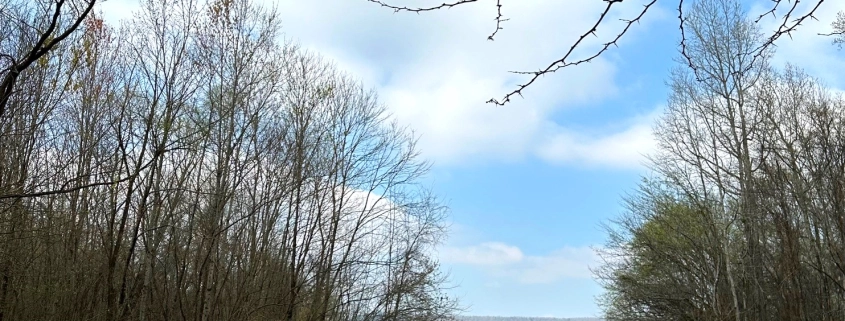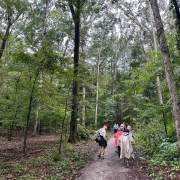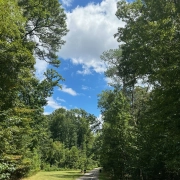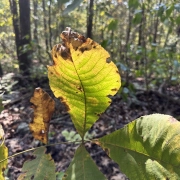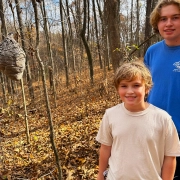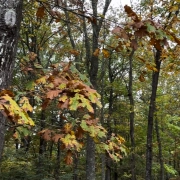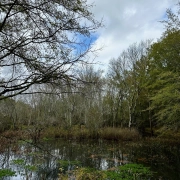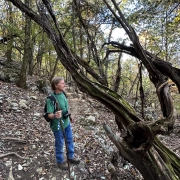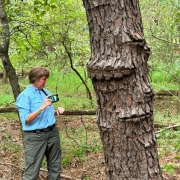A Late March Return to Goldsmith-Schiffman after Flood Waters Recede!
I returned to Huntsville, Alabama’s Goldsmith-Schiffman Wildlife Sanctuary on March 23, 2014, just a week after the flooding Flint River prevented my Huntsville LearningQuest class from touring the Sanctuary: https://stevejonesgbh.com/2024/04/02/brief-form-post-29-mid-march-attempt-to-enter-the-flint-river-flooded-goldsmith-schiffman-wildlife-sanctuary/
During the intervening week of fair weather, the Flint receded, spring advanced, and the Sanctuary beckoned me to explore the breadth of its eastern side. A week prior, I would have been knee-deep taking the photo at left, which looks northwest to the Blevins Gap Ridge, 800 feet above the valley floor. The view at right to the trailhead would have traced water to the entrance sign, where the tour group posed a week ago.
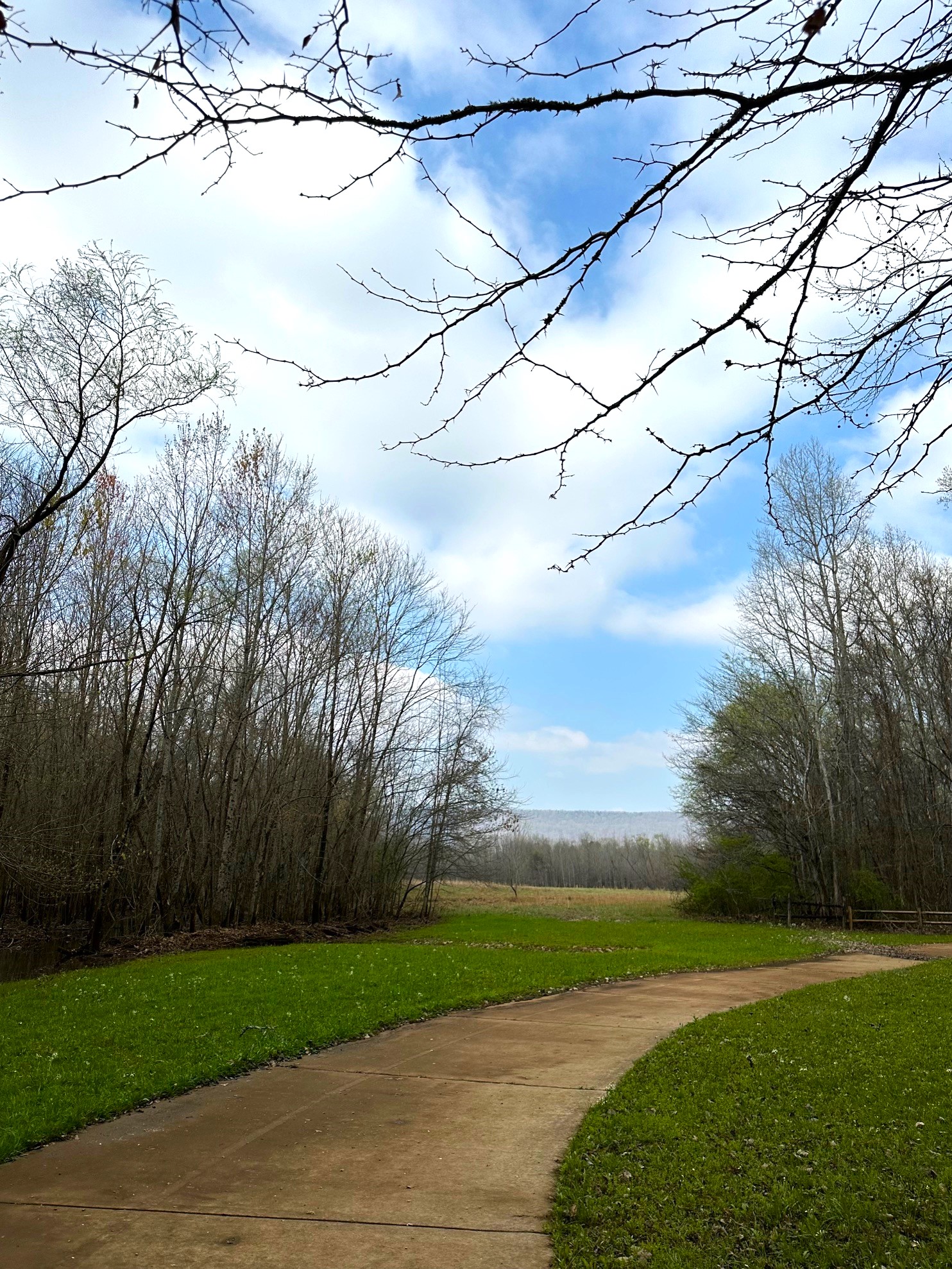
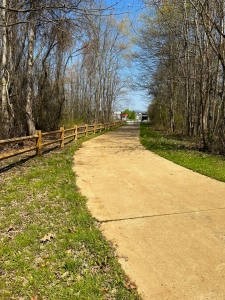
I welcomed the dry surface of the greenway.
The Flint River Tamed
At 10:30 AM a quarter of a mile from the entrance, the Flint flowed tranquilly at bankful, upstream at left and downstream to the right.
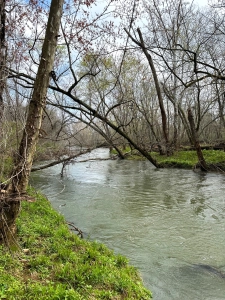
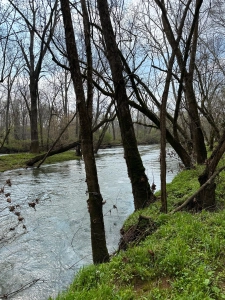
A short video (39 seconds) tells the river’s tale this fine spring morning…far better than my feeble words and still photos:
The natural upland levee along the flint stood above the flood waters the week before. I pondered what mood standing isolated there surrounded by floodwaters would have evoked.
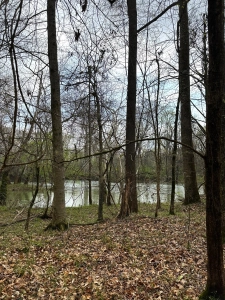
A lifelong fan of esteemed conservationist Aldo Leopold, I turned to his writings (A Sand County Almanac) for an apt quotation:
There are degrees and kinds of solitude. An island in a lake has one kind; but lakes have boats, and there is always the chance that one might land to pay you a visit. A peak in the clouds has another kind; but most peaks have trails, and trails have tourists. I know of no solitude so secure as one guarded by a spring flood; nor do the geese, who have seen more kinds and degrees of aloneness than I have.
Spring Ephemerals
The woodland trail I transited parallels the river (to the right) and the deep riparian forest that stretches to the tupelo swamp several hundred yards to the left. The path, via debris deposited by the recent flood, evidences a foot of overflow a week prior.
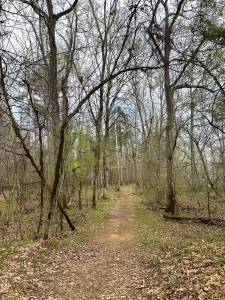
These dwarf trilliums at full flower likely observed the flood through a watery lens if they had already emerged from the saturated forest soil.
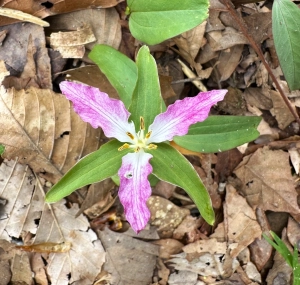
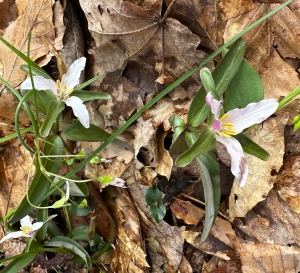
Their cousin, a twisted trillium, is just opening. Spring ephemerals are my favorite forest botanical denizens. The term ephemeral implies the narrow temporal window they occupy. They flourish during the period beginning when the canopy-penetrating spring sun warms the soil and ending when overstory tree foliage prevents sunlight from reaching the forest floor. Spring floods this year punctuated the brief optimal period. Such are the vagaries of ephemeral gardening and spring field trips.
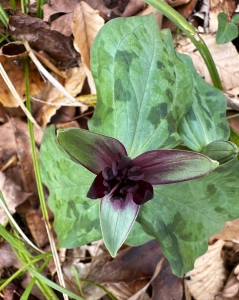
Among the plentiful trilliums, I spotted Virginia saxifrage (left) and rue anemone strutting their stuff.
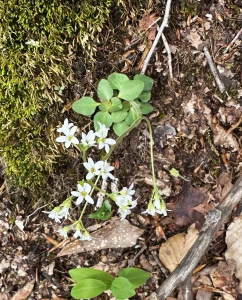
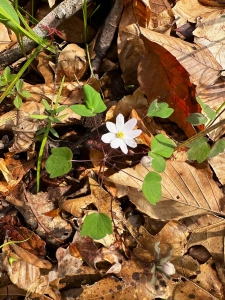
Bristly buttercup (left) and blue phlox also welcomed me with a little strutting of their own.
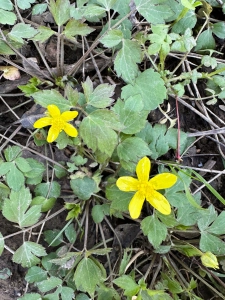
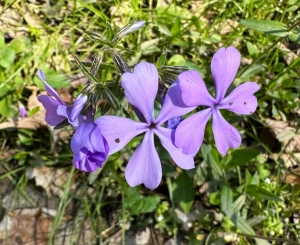
Because I had not yet reached full woods-worthy rambling recovery from my January 23, 2024 knee surgery, I sauntered cautiously, wary of tripping vines and hidden depressions, taking care, too, not to exceed my still limited strength and endurance. I know that I could have catalogued dozens of wildflower species with a deeper exploration. Next spring!!
Panoply of Routine Spring Woodland Delights
I have never followed or even cared to know much about fashion of the human apparel kind. Instead, I wish you good luck prying me away from Nature’s seasonal garb. Every year she demonstrates mastery of the hues, tones, and incalculable shades of spring greenery. By mid-April she drapes fields, forests, meadows, and marshes with verdant wonder, color varieties in excess of known monikers. I’ve tried year after year to photographically capture the green varietal splendor, yet I fall short of target. Instead, I focus the camera on the sublime moss skirts, a routine woodland delight accented by spring rains, and common across our forests.
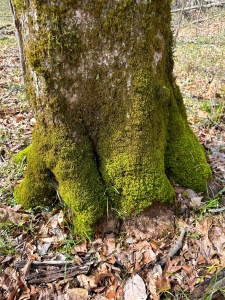
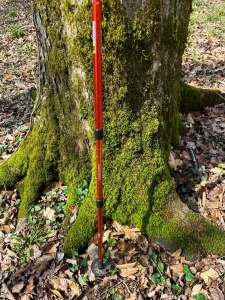
My Mom and her mother (Grandma Jacobs) fueled my youthful passion for plants, mainly flowering garden annuals. Little did I know that my enthusiasm would blossom into vocation, and lifelong avocation, oriented to trees and associated forest ecosystems. I never tire of musing on these vast three-dimensional living systems. The Sanctuary riparian trees reach 100 feet. The forest matrix and its life occupy 4,356,000 cubic feet per acre. I gaze with wonder into the forest side-view (left) and vertically (right). A hint of green presages another routine spring woodland delight.
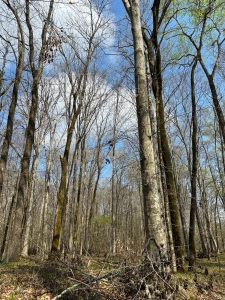
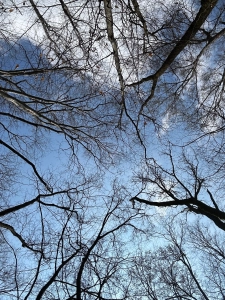
Woodland delights are hidden in plain sight for those who know where to seek them. Honey locust, a native hardwood tree, sports wicked looking compound thorns.
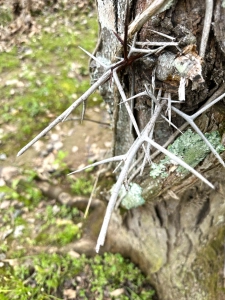
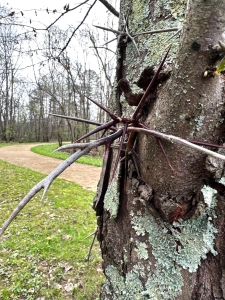
The species also offers a bark pattern I have yet to recognize reliably, sometimes smooth, ranging to rigid vertical plating. I can’t yet come upon a honey locust and immediately declare its identity with certainty unless, of course, I spot the compound thorns.
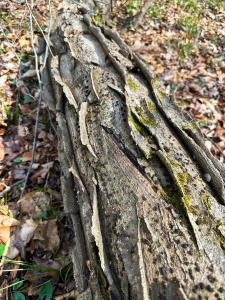
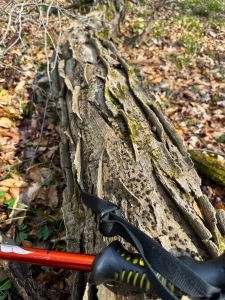
In contrast, persimmon bark reaches out to me even from a distance, its blocky nearly black stem shouting, “Hey you dim-witted old forester, it’s me…persimmon. You surely remember me, Diospyros virginiana!”
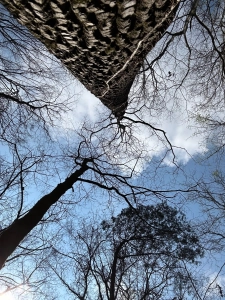
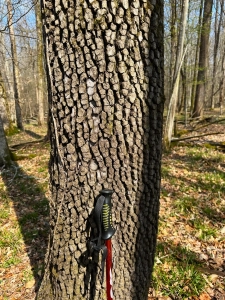
Some other common Sanctuary species suggest their identity by bark and form. American beech trees have smooth elephant hide bark and wide spreading crowns, even broader than an oak of similar trunk diameter. Each forest tree offers its unique personality, its individual woodland delight.
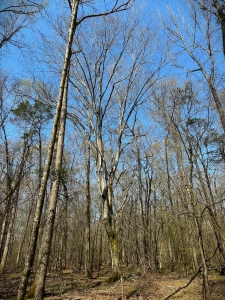
Spring delights come in many forms and appeal variably according to the interests and passions of the woods wanderer. Compound thorns, moss skirts, and elm fungus mushrooms represent points along the complex circle of life within the Sanctuary’s forest ecosystem. Any single riparian forest acre spreads its delight-bounty within a 4.356 million cubic foot magical kingdom. I wonder what I did not see. What did I miss?
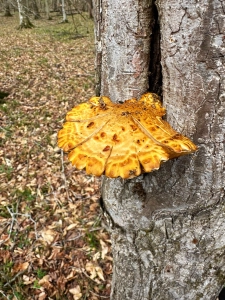
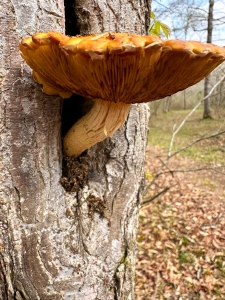
How fortunate was I to stumble at eye level across this member of the fungi kingdom? It’s common name: deer vomit mushroom.
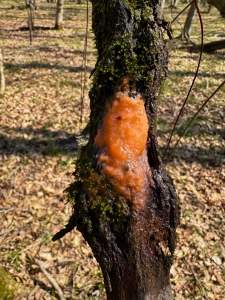
I found information worth sharing (itself a special delight) on an obscure website called Mushroom Monday:
Good afternoon, friends,
This week’s fungus looks like spray paint, and it’s not even just one fungus; it’s a plasmodial soup of several different fungi and microorganisms referred to by the vile (and bile) name “deer vomit” (Fusicola merismoides). I learned about this last Monday on the New York Mycological Society zoom ID session and then found it on Saturday during a chainsaw training class I took in the Catskills. Sometimes referred to as a “fungal volcano” or a “fungal potpourri”, this spring-time slime is often found on the cut limbs of trees and native grape vines (Vitis labrusca and Vitis riparia).
Fun Facts
Every specimen of F. merismoides that has been DNA barcoded has come back with a different sequence which suggests that each slime is a unique complex of different organisms. Just like a snowflake, no two are the same. The orange color comes from the fungus Fusicolla merismoides (previously Fusarium merismoides), an ascomycete that consumes some of the other yeasts and microorganisms in the flux. The slime essentially has its own ecology where some species of fungi and microbes are growing symbiotically while some are parasitizing each other – but that’s not too different from what’s going on inside our own body.
I try to visit the Sanctuary every 2-3 months, monitoring change and discovering what Nature reveals. This trip proved especially rewarding. How else might I have encountered such a lovely example of a primordial soup; a fungal volcano!?
Thoughts and Reflections
I offer these observations:
- Nothing in Nature is static — the Sanctuary is in constant motion.
- Open your eyes to the magic and wonder of such delights as a primordial soup or a fungal volcano!
- Can you imagine a simple delight more magnificent than our prodigious spring ephemeral wildflowers!?
Inhale and absorb Nature’s elixir. May Nature Inspire, Inform, and Reward you!
Note: Unless otherwise noted, all blog post images are created & photographed by Stephen B. Jones. Please circulate images with photo credit: “©2024 Steve Jones, Great Blue Heron LLC. All Rights Reserved.”
Another Note: If you came to this post via a Facebook posting or by another route, please sign up now (no cost… no obligation) to receive my Blog Post email alerts: http://eepurl.com/cKLJdL
And Third: I am available for Nature-Inspired Speaking, Writing, and Consulting — contact me at steve.jones.0524@gmail.com
A reminder of my Personal and Professional Purpose, Passion, and Cause
If only more of us viewed our precious environment through the filters I employ. If only my mission and vision could be multiplied by untold orders of magnitude:
Mission: Employ writing and speaking to educate, inspire, and enable readers and listeners to understand, appreciate, and enjoy Nature… and accept and practice Earth Stewardship.
Vision:
- People of all ages will pay greater attention to and engage more regularly with Nature… and will accept and practice informed and responsible Earth Stewardship.
- They will see their relationship to our natural world with new eyes… and understand their Earth home more clearly.
Tagline/Motto: Steve (Great Blue Heron) encourages and seeks a better tomorrow through Nature-Inspired Living!
Steve’s Three Books
I wrote my books Nature Based Leadership (2016), Nature-Inspired Learning and Leading (2017), and Weaned Seals and Snowy Summits: Stories of Passion for Place and Everyday Nature (2019; co-authored with Dr. Jennifer Wilhoit) to encourage all citizens to recognize and appreciate that every lesson for living, learning, serving, and leading is either written indelibly in or is powerfully inspired by Nature.
I began writing books and Posts for several reasons:
- I love hiking and exploring Nature
- I see images I want to (and do) capture with my trusty iPhone camera
- I enjoy explaining those images — an educator at heart
- I don’t play golf!
- I do love writing — it’s the hobby I never needed when my career consumed me
- Judy suggested my writing is in large measure my legacy to our two kids, our five grandkids, and all the unborn generations beyond
- And finally, perhaps my books and Blogs could reach beyond family and touch a few other lives… sow some seeds for the future
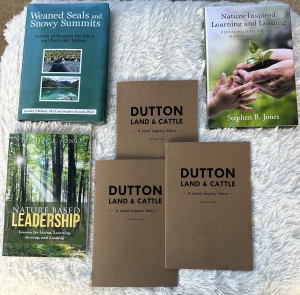
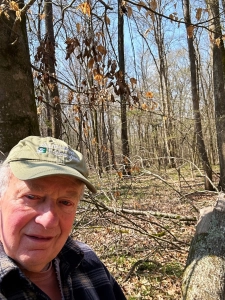
All three of my books (Nature Based Leadership; Nature-Inspired Learning and Leading; Weaned Seals and Snowy Summits) present compilations of personal experiences expressing my (and co-author Dr. Wilhoit for Weaned Seals and Snowy Summits) deep passion for Nature. All three books offer observations and reflections on my relationship with the natural world… and the broader implications for society. Order any from your local indie bookstore, or find them on IndieBound or other online sources such as Amazon and LifeRich.
I now have a fourth book, published by Dutton Land and Cattle Company, Dutton Land & Cattle: A Land Legacy Story.

